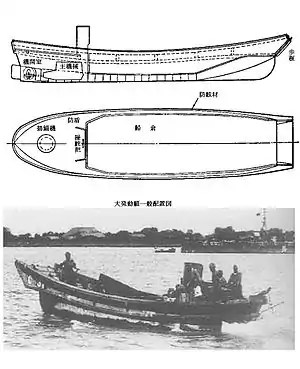Daihatsu-class landing craft
The Daihatsu-class or 14 m landing craft (大発, abbreviation of 大型発動機艇 which means "large motorized boat") was a type of landing craft used by the Imperial Japanese Army from 1937 to 1945, in the Second Sino-Japanese War and World War II. It was designated the "Type A" landing craft by the United States.[1][2]
 | |
| Class overview | |
|---|---|
| Name: | Daihatsu class |
| Operators: |
|
| In service: | 1937–1945 |
| Planned: | 3,229 |
| General characteristics (Daihatsu-class landing craft) | |
| Type: | Landing craft |
| Tonnage: | 21 tons |
| Length: | 47 ft (14.33 m)o/a |
| Beam: | 10 ft (3.05 m) |
| Draught: | 2.6 ft (0.79 m) |
| Installed power: | 60 hp (45 kW) |
| Propulsion: | Diesel engine |
| Speed: | 8 knots (14.8 km/h) |
| Range: |
|
| Capacity: | 1 Type 95 7.4 ton tank or 70 men or 10 tons cargo |
| Complement: | 12 |
| Armament: | 2 light machine guns or 2-3 25mm/60 AA guns |
History
It had a bow ramp that was lowered to disembark cargo upon riding up onto a beach. After reviewing photos of a Daihatsu landing craft, this was adopted by American landing craft designer Andrew Higgins[3][4] in developing the Landing Craft, Personnel (Large) (LCP(L)) into the Landing Craft, Personnel (Ramped) (LCP(R)) and later the Landing Craft, Vehicle and Personnel (LCVP). However, the Daihatsu landing craft was more seaworthy than an LCVP due to its hull design. It was constructed of a metal hull and powered by a diesel engine.
The landing craft could be modified to carry weapons of up to 37 mm (1.46 inch) caliber as armament and could be uparmoured against 40 mm fire. The 17 meter Toku Daihatsu-class landing craft was a lengthened version that was capable of carrying a medium-sized tank or two eight ton tanks.
Gallery
 An example captured at the Battle of Milne Bay
An example captured at the Battle of Milne Bay Imperial Japanese Army practicing landings with the Daihatsu landing craft, 1935.
Imperial Japanese Army practicing landings with the Daihatsu landing craft, 1935.
References
- ONI 208-J (Supplement no. 2) Far Eastern Small Craft. Division of Naval Intelligence. March 1945. p. 22-23.
- U.S. Army-Navy Journal Of Recognition. March 1944. pp. 42–43.
- Neushul, Peter (1998). "Andrew Jackson Higgins and the Mass Production of World War II Landing Craft". Louisiana History: The Journal of the Louisiana Historical Association. 39 (2): 133–166. ISSN 0024-6816.
- Goldstein, Richard (5 January 2009). "Victor H. Krulak, Marine Behind U.S. Landing Craft, Dies at 95 (Published 2009)". The New York Times. ISSN 0362-4331. Retrieved 28 December 2020.
- Jentschura, Hansgeorg; Jung, Dieter; and Mickel, Peter. Translated by Brown, J.D. 1977. Warships of the Imperial Japanese Navy, 1869–1945. Naval Institute Press. ISBN 0-87021-893-X.
- Morison, Samuel Eliot. 1950. History of United States Naval Operations in World War II, Volume VI: Breaking the Bismarck Barrier, 22 July 1942 – 1 May 1942. Boston: Little, Brown, and Company.
- Parillo, Mark P. 1993. The Japanese Merchant Marine in World War II. Naval Institute Press. ISBN 1-55750-677-9